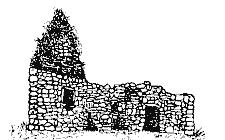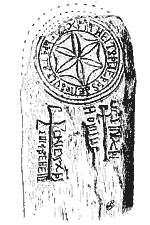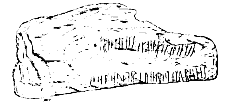
[From Illustrated Notes on Manks Antiquities, 1904]
[note still under construction - figures tba]
The Historic Period is represented by structural and monumental remains, dating from the introduction of Christianity to the earlier Celtic inhabitants in the sixth or end of the fifth century. Among these remains are a number of inscribed stones and incised and carved Cross-slabs (see figs. 24 to 42) ; and the ruins and foundations of early Keeils, Cells, or Churches.
Dr. Oliver, in the Manks Society, Vol. I.V. (1868), describing the ancient churches in Man, states that " In their materials and construction they correspond with the account given in the Book of Armagh of similar places of worship in Ireland of the age of St. Patrick. When the Apostle visited Tirawley (he quotes) he built there a quadrangular Church of moist earth, because there was no wood near." Here, he adds, " we have an exact description of the Manx cabbal. . . . The cabbal and keeil are invariably quadrangular, the lights oblong or quadrilateral openings, splaying inwards, and the stonework of the doors and windows unchiselled." Since his time many buildings and ruins have been utterly demolished, and we are unaware of any instance answering to his description of " the Cabbal of the Fifth Century," of which he gives a figure, but does not say- what it is taken from. He then goes on to describe the keeils, which he supposes to have been " introduced about the middle of the sixth," of which lie gives St. Lingan's, Marown, as an instance; the " Treen " Churches, " introduced towards the close of the eighth," instancing Ballakilley, Malew ; and " Mortuary Chapels," such as St. Luke's, on the western slope of Cronk-ny-Irree-Laa, Rushen. We are unable to follow his classification, or to agree (from what little can be learned from still existing remains) with his descriptions in every particular.
The following are the most interesting of which traces still remain: -
Keeil Woirrey, in Corna Valley, Maughold, measures (inside) 12 feet by 9 feet, the walls over 3 feet thick and 4 feet high, but 2 feet high outside. The floor shows signs of pavement. The doorway is at the S.W. corner. The surrounding burial ground measures about 93 feet by 60 feet. Among the stones of the ruined wall was one bearing a very simple form of cross, which judging from its appearance may be earlier than the seventh century (see fig. 24, left side). Near this keeil, an interesting discovery was made some years ago by the Rev. S. N. Harrison, who came across a rough unhewn slate slab, used at a well beside the little stream below, which bears an inscription (see fig. 41) in the ordinary Manks runes with a formula differing from any previously met with, namely
Krist, Malaki, and Patrick (and) Adamnan. Unal (O'Neal's) shepherd Juan carved this in Kurna dale.
Probably it was cut in the 13th century by Juan of the sheep, while watching his master's flock in the valley, and he was thus distinguished from another, namely, " Juan the Priest," who about the same time carved runes on a somewhat similar rough slab at the parish church.
On Balla-fayle, in the same parish, overlooking the sea at the south end of Port Mooar, are the remains of Keeil Casherick, or Keeil Chiggyrt, as it is also called. In the surrounding burial ground was found a wheel-headed cross-slab, now to be seen at the parish church. Sculptured on one face is an equal-limbed cross with knot-work decoration, below which is a, human figure probably intended for Christ.
On Ballingan, Marown, are the ruins of a keeil and burial ground. The enclosure is 108 feet long by 63 feet broad. In the south-east part lies the keeil, its walls about four feet high by three thick. In the west end has been a window; the doorway is in the south-east angle, built of rubble stone work with two monolithic jambs inclining. The font measures 1 foot 11 inches long by 102 inches broad.
Sir Henry Dryden has left (1873) an unpublished plan of another keeil on the adjoining estate of Ballaquinney in the same parish, which we reproduce as a typical instance (fig. 25). It measured 15 feet 4 inches by 10 feet inside. The door is in the west wall, 1 foot 9 inches wide, and the walls are about 5 feet thick.
Fig 25
Dr. Oliver gives an account 1 (1868) of a Treen Church at Ballakilley, Malew, with a gable which we here reproduce (fig. 26). It is about 50 yards from the farmhouse, and measures 21 feet by 9 feet. "The western gable crowned with ivy is still standing, but the east end is in ruins.' It is built of rounded boulders of granite and quartz, giving it a very peculiar appearance. The walls are " 6 feet 3 inches from the ground to the spring of the roof; and the western gable 16 feet 9 inches to the peak. In the south wall near the eastern angle is the door of entrance, 5 feet 2 inches in height, by 2 feet 6 inches at base, diminishing upwards to 2 feet. Opposite, in the north side, is a square-headed window, and another in the south wall near the west end. This window externally is 2 feet 6 inches high by 1 foot 6 inches broad, splaying inwards ; internally 2 feet 6 inches by 3 feet. In the north-west angle of the gable is a similar window, 1 foot 5 inches by 9 inches, splaying internally to 20 inches in breadth and 17 inches in length (see fig. 26).
One of the most interesting of these early keeils is that known as St. Luke's (St. Luac), on the lonely shore at the western foot of Cronk-ny-Irree-Laa. Oliver (Id. p. 89), upon what authority we do not know, says " It is traditionally known as the Church and Cemetery of the Danish Kings." It is a stone erection, built without cement, " but the masonry is more regular and much better constructed " than in the case of these other keeils. The floor was paved with pebbly stones. It measures, outside, about 18ft. by 15ft., the walls being about 2ft. 6in. thick, their inside height 4ft. from the floor, outside 3ft.
Burial, in the ancient cemeteries round these keeils, was in " lintel-graves," about 3ft. deep and 2ft. wide, dug east and west, and lined with small flagstones to the height of 15 inches. The corpse was wrapt in a mort-cloth, and the top closed in by similar, sometimes rather larger flags. No implements or relics have been found in any of these graves. Sometimes, says Oliver, two and even three bodies rest in the same grave. " When this is the case they will be found to lie on their sides, with the lower extremities semi-flexed. In consequence of this the grave is smaller, having the appearance of a child's burial. Three or four such graves may be seen in section at Kilkellane, Lonan, where the electric tram road has cut through a burial ground. Sometimes such early cemeteries are found where now there is no trace or tradition remaining of the keeil which must once have stood there, as at the Flagstaff above Glen Wyllin, Michael, and by the old Castletown road from Foxdale, on Barrule Farm. Occasionally these lintel-graves are met with even in the Parish Churchyards, having continued in use until the commencement of the seventeenth century.

Fig. 26. Treen at Ballakilley.
It is in connection with these old keeils and the later Parish Churches, some of which are on the ancient sites, that those carved stone monuments have been found in which the Isle of Man is so peculiarly rich. With but few exceptions these are sepulchral, and take the form of upright slabs of local stone, ranging from about 2ft. 6in. to six and, in a few cases, seven or eight feet high, by about 15in. to 24in. wide, and from two to four inches thick. They are generally " rectangular, sometimes having the upper corners rounded off, and sometimes the whole head in what has been called a wheel-cross. Occasionally the spaces between the limbs and the surrounding circle are pierced, and, in a very few instances, the slab is itself cruciform.2

Fig. 27. Ogam inscriptions. Diagram by P . M. C. K. .
Of the inscriptions, a few are in "Ogams"-characters forming an artificial alphabet, invented possibly by Irish scholars, who had become acquainted with the Roman inscriptions in Wales. Two of these have been found at Bemaken Friary, Arbory, and two in the burial ,round of an early keeil at Ballaqueeney, Rushen. In language and character they exactly resemble Irish inscriptions of about the fifth century (see fig. 27).

Fig. 28. Inscribed stone from Maughold.
One or two are in debased Roman, or Early British characters and Latin language of the sixth, seventh, or eighth centuries. The most interesting of these is a small slab found at Maughold, by Mr. P. M. C. Kermode, in 1901, and figured and described in "The Reliquary and Illustrated Archaeologist," July, 1902. Around a circle enclosing a Hexafoil design is the following inscription, of which, unfortunately, the beginning is broken off :-. . . NE ITSPLI EPPS DE INSVL. It is here met by some characters running in the opposite direction, of which one can make out the letters-BPAT. Below the circle are two small crosses (of the very rare form met with at Kirk Madrine, Wigtown) down by the sides of which runs the following unique formula: -
[FECI] IN Xpi HOMIHE
CRVCIS Xpi IMAGEHEM.
With two exceptions the H form stands for N (fig. 28). This is probably earlier than the 8th century. Another cross, formerly on a hedge at Port-y-Vullen, Maughold, but now in the churchyard, bears across the edge the simple inscription, Crux Guriat, a name met with in North Wales in the 9th century. The upper part of our figure 29 shows the inscription from a rubbing, one fourth actual size.

Fig 29. Inscribed Cross from Kirk Maughold. Crux Guriat.
The greater number of these inscriptions are, however, in " Runes," the peculiar characters developed three or four centuries before the Christian era by the Goths, who came in contact with the Greek colonists from the Black Sea trading for amber. These characters underwent great changes in the course of centuries, and are classed according to their period as Gothic, Anglian, and Scandinavian. A solitary example of the Anglian runes of about the eighth century has recently been found at Maughold. Only eight characters now remain, a twelfth part of the inscription, if, as seems likely, it was continued round the circle. They are perfectly legible, reading in the first-BLAGC-MON The stroke between the C and M may be accidental, or it may be a punctuation sign. If forming one word, this would make a known Anglo-Saxon name. The rest of the Manks inscriptions are in the later Scandinavian runes of the tenth to the thirteenth century.

Fig. 31. Cross from Calf of Man.
The earlier pieces are of unhewn stone, and bear on one or both faces incised crosses of different forms (fig. 24). Later, we find the crosses sculptured in relief, and the stones more or less elaborately decorated, " a regular development may be observed from the most simple plait and twist to the most complex and beautiful geometric designs, and then from the geometric to the zoomorphic (figs. 29 and 30). A striking feature is the realistic and admirably drawn forms of birds and beasts of the chase and of men, though the latter are not generally a success, and occasionally of the human form with heads of birds or with wings." Some of the designs, as well as the general decorative treatment, are peculiar to the Isle of Man, and all exhibit true artistic feeling, and most of them skill in execution. A few of the older Celtic pieces exhibit Scripture scenes:-The Temptation of Adam and Eve (Bride), Daniel in the Lions' Den (Braddan), The Virgin and Child (Maughold), and the unique Crucifixion from the Calf of Man, an example of pure Byzantine art (fig. 31). It is also of peculiar interest to note the work of the first Scandinavian Christian sculptors, following the earlier Celtic models with great freedom and evolving effective designs from the most simple motives. Finally, we find on later pieces illustrations from the old Norse Myths (figs. 32 to 36)-a series illustrating the story of Sigurd Fafni's-Bane, and figures of the gods Odin, Thor, and Heimdall, and of giants, dwarfs, and monsters. A complete collection of casts of over 100 crosses taken by Mr. T. H. Royston, of Douglas, finds a temporary location in the Masonic Rooms, Ramsey, and nearly all have now been figured for Mr. Kernnode's book on the subject. We reproduce in the preceding eight pages, a series of ten typical examples, as follows:
Fig. 32. Sigurd. Jurby.
Fig. 33. Sigurd. Malew.
Fig. 34. Odin. Jurby.
Fig. 35. Hrae -svelgr (Grim's Cross). Michael.
Fir. 36. Heimdall. Jurby.
Fig. 37, Bishop's Monument (? Kirk Maughold.
Fig. 38. Celtic Cross. Kirk Maughold.
Fig. 32 shows a slab 7 feet long which was found as gate-post of a field at Jurby. Alongside the shaft of the cross we see, above, Sigurd in his pit-here ingeniously represented as a hollow mound- in the act of slaying the Dragon; below, he is shown sucking the thumb he had burnt in roasting the dragon's heart. One of the talking birds and Sigurd's steed Grani are also shown.
Fig. 33 is a slab 5 feet long, from Malew, showing on the right, below, Sigurd from his pit piercing the Dragon. Above, Sigurd is shown holding the wand upon which the dragon's heart is roasting over a fire represented by three triangular flames, and sucking his burnt thumb which reveals to him the knowledge of what the birds around are saying. On the other side the steed Grani is shown, above, and below the panel is broken. The three Sigurd pieces known from the Island are claimed to have been carved by the famous Gaut Bjornson, of Cooly.
Fig. 34 is a fragment from Jurby, showing a stag and a boar to the right, and on the left a scene which is probably eagle-headed Odin taking a hero to Valhalla.
Fig. 35 shows what is known, from the inscription on it, as " Grim's -Cross," from Michael. On the right at top is the wind-giant, Hrue-svelgr, corpse- devourer, in the form of a war-eagle or vulture tearing the body of some hero unknown.
Fig. 36.-The head of the inscribed cross from Jurby shows Heimdall, the warder of the gods, standing at the foot of the rainbow bridge (Bifr6st) blowing a blast on his horn (Gialla) to summon the gods to their last great battle at Ragnarbk, where they have to encounter the giants, demons and powers of evil.
Fig. 37 represents a sculptured slab from Kirk -AIaughold which, from the figure with book and pastoral staff, is possibly the monument of a bishop. The rest of the carving shows scenes of the chase-a stag and one or more hounds.
Fig. 38 is a very beautiful example of pure Celtic design and workmanship. It served for many years as lintel to the west door of Kirk Maughold. Here again a figure of a priest is shown, with stags and hounds below.
Figs. 39 and 40 show the two sides of Roolwer's Cross, Maughold, which Mr. Kermode believes was set up to the memory of Hrolfr, a Scandinavian who, as " Roolwer," is recorded in Chronicon Manna; as being Bishop in Man about 1050.

Fig. 41.-Runic Inscription from Corna in Maughold.
Fig. 41 is the slab from Corna with the runic inscription carved by John-o'-the-sheep referred to above. The similar example of runes " writ by John the Priest " is unfortunately too large to be reproduced on our page. A figure of it will be found in Mr. Kermode's paper in " The Reliquary " for July, 1902.
1 Manks Society, Vol. XV., p. 88.
2 Catalogue of Manks Crosses, P.M.. C. Kermode, 2nd Ed., p. 4.
3 We are much indebted to the courtesy of the publishers of that periodical for the kind loan of some of the blocks which illustrated Mr. Kermode's paper.
4 Catalogue of. Manks Crosses, 2nd Ed.
|
|
||
|
|
||
|
|
||
|
Any comments, errors or omissions gratefully received
The Editor |
||